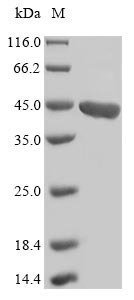Thanks for your inquiry.
Recombinant Arabidopsis thaliana Flavonol synthase/flavanone 3-hydroxylase(FLS1)
CSB-EP842601DOA >> E.coli
Express region:1-336aa;Full length protein.
Tag information:N terminal 10xHis-tagged + C terminal Myc-tagged
Sequence:
MEVERVQDISSSSLLTEAIPLEFIRSEKEQPAITTFRGPTPAIPVVDLSDPDEESVRRAVVKASEEWGLFQVVNHGIPTELIRRLQDVGRKFFELPSSEKESVAKPEDSKDIEGYGTKLQKDPEGKKAWVDHLFHRIWPPSCVNYRFWPKNPPEYREVNEEYAVHVKKLSETLLGILSDGLGLKRDALKEGLGGEMAEYMMKINYYPPCPRPDLALGVPAHTDLSGITLLVPNEVPGLQVFKDDHWFDAEYIPSAVIVHIGDQILRLSNGRYKNVLHRTTVDKEKTRMSWPVFLEPPREKIVGPLPELTGDDNPPKFKPFAFKDYSYRKLNKLPLD
Buffier: 20 mM Tris-HCl, 0.5M NaCl, pH 8.0






